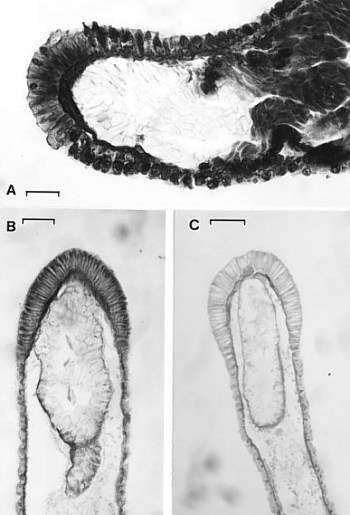
Coral feeding - defensive adaptations
PHOTO
Longitudinal sections of tip of ceras, showing 'terminal sac' and concentration of unique epithelial glands. A, Phestilla minor. B, C, Phestilla lugubris: Scale bar = 20 microns. PHOTOS: Bill Rudman.
RELATED TOPIC
The most obvious protective device employed by the four nudibranchs found on Porites (Phestilla lugubris, Phestilla minor, Cuthona poritophages, Pinufius rebus), is camouflage and hiding. They are on the whole cryptically coloured. Even the white colour form of Phestilla minor resembles the white fish-feeding scars often found on Porites colonies. The other defensive strategy is to hide. Most animals living on the underside of a colony or in crevices. Most aeolids have a specialised cnidosac at the tip of their cerata, in which are stored defensive stinging cells (nematocysts) which they remove from the cnidarian on which they are feeding. It is significant that the three aeolids feeding on Porites have either no cnidosac (Phestilla spp.), or it is non-functional (Cuthona poritophages). The nematocysts in Porites are relatively small and apparently not effective for defence. They have been replaced in these three aeolids by greatly developed glandular cells in the skin at the tip of the cerata. This swollen galndular ceratal tip is characteristic fo the genus Phestilla. in Cuthona poritophages and apparently non-functional cnidosac still remains but osmiophil gland cells which are usually scattered throughout the ceratal wall, in most species of Cuthona, are concentrated and much more numerous in the ceratal tip.
References:
•Rudman, W.B. (1979) The ecology and anatomy of a new species of aeolid opisthobranch mollusc: a predator of the reef-forming coral Porites. Zoological Journal of the Linnean Society 65: 339-359.
•Rudman, W.B. (1981) Further studies on the anatomy and ecology of opisthobranch molluscs feeding on the scleractinian coral Porites. Zoological Journal of the Linnean Society 71: 373-412.
•Rudman, W.B. (1982) The taxonomy and biology of further aeolidacean and arminacean nudibranch molluscs with symbiotic zooxanthellae. Zoological Journal of the Linnean Society 74: 147-196.
Rudman, W.B., 1999 (October 4) Coral feeding - defensive adaptations. [In] Sea Slug Forum. Australian Museum, Sydney. Available from http://www.seaslugforum.net/factsheet/corafeed3
